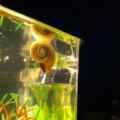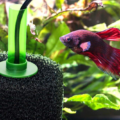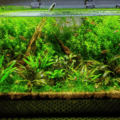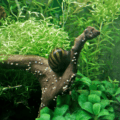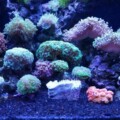In this comprehensive guide, we delve into the dietary needs of bettas, exploring the best foods to keep your fish healthy and thriving. From live foods to frozen and freeze-dried options, we uncover the top choices for your betta’s palate.

In this sense, the primary sources of food for our betta fish should be high in animal fiber and protein.
However, some commercially available foods that fit this description should be avoided as they can do more harm than good. Some brands include plant-based proteins in their formulas, which is useless for carnivorous fish such as the Betta.
For this reason, finding the right ones on your own might prove difficult.
So, I’ve compiled a list of the best foods you can feed your Betta.
I will show you how to satiate the hunger of your fighting fish without the extra cost to their well-being.
Food for Betta fish: What should you feed your new pet fish?
Betta fish, also called Siamese fighting fish, possess colorful and attractive fin patterns, and because of their beauty, they are a good option for aquarium hobbyists.
However, care must be taken to provide better-quality food, which is necessary for their health and longevity.
Bettas are carnivorous fish, so they have distinct nutritional requirements that must be met to keep them lively and vibrant.
The importance of a proper diet for Betta fish:
The Provision of a proper diet is essential for betta fish. A balanced diet not only keeps fish healthy but also improves their vibrancy and vitality, so the owner must understand this.
Failing to meet dietary needs can cause numerous health problems, such as fin rot, swim bladder disorders, a shortened lifespan, etc.
Betta fish are carnivores; they feed on small insects, larvae, and other aquatic animals in their environment.
Replicating their natural feeding habits is critical for good health and longevity. Commercially prepared Betta fish food, consisting of pellets, flakes, and freeze-dried or frozen choices, is specifically manufactured to cater to the nutritional needs of Betta fish.
Frequency of feeding is an important consideration in Betta fish care. Even though Betta fish have strong appetites, they should be fed once or twice daily according to their dietary requirements; otherwise, there is a problem of obesity.
What Is The Best Food for a Betta Fish?
For a quick overview of our top fish food choices checkout this table below:
| Betta Fish Food listing | Type of Betta Fish Food | Cost |
| Omega One Betta Combo | Freeze-Dried, Flake, & Pellet Betta Food | $ (Best Value) |
| Instant Baby Brine Shrimp | Live Foods | $$$ |
| Omega One Freeze Dried Mysis Shrimp | Freeze-Dried Foods | $$ |
| Tetra BettaMin Flakes Medley | Flake Food | $ |
| Tetra Betta Small Pellets | Pellet | $ |
Feeding fish has never been easier, with pet stores stocking several options for all kinds of aquatic animals.
Just as with most other aquatic pets, Betta fish can be fed with a variety of foods, including regular fish food.
Most people choose to give Betta fish foods that are live, frozen, freeze-dried, or some combination of all three alongside pellets and flakes.
In the wild, siamese fighting fish enjoy a diet of insects and insect larvae such as mosquito larvae, midge larvae, and bloodworms. They are also known to eat fish fry and small aquatic crustaceans like brine shrimp.
Of course, your pet betta isn’t in the wild, and its diet won’t be quite the same but you should try to replicate it.
Choosing the best Betta food is of utmost importance for the health and vitality of your Betta fish. There isn’t a hard and fast rule to feed Betta fish; a diverse diet can be provided that consists of a combination of live, frozen, freeze-dried, and alternative foods to ensure your Betta gets a balanced diet.
Here’s what the best betta fish foods are:
Live foods

Live foods are some of the healthiest options you can offer your fish, as long as they come from a trusted source.
They force your betta to hunt in the water, keeping it stimulated. Healthy bettas also tend to look more vibrant than those fed with nothing but pellets and flakes.
If you choose to feed your new betta with high-quality live foods, you have several options that are easy to manage.
The most popular are bloodworms, brine shrimp, mosquito larvae, and wingless fruit flies.
While bettas thrive on live foods, they can sometimes be picky eaters. By replicating what they would eat in the wild, you ensure that all of their nutritional needs get met.
The foods listed below are all part of the natural betta diet:
- Mosquito Larvae:
In the wild, bettas eat mosquito larvae, making these a top pick.However, they are difficult to secure from a reputable seller.
- Micro worms:
One of the most accessible live betta foods you can cultivate on your own is protein-rich micro worms.It only takes a few days to get your first batch, and bettas love them.
- Earthworms:
Earthworms might seem like an odd pick, but they provide a fantastic source of protein for bettas.Just keep in mind that larger worms may need to be chopped into smaller pieces, so this might not be for the faint of heart.
- Live Brine Shrimp:
Live brine shrimp provide high protein content to bettas and are a flexible option.Babies can be fed to betta fry while adult brine shrimp offer a tasty treat to fully-grown bettas.
- Daphnia:
Daphnia are tiny planktonic crustaceans that look like a mix of fleas and shrimp.They are not only high in fiber, but are also jam-packed with essential vitamins, proteins, and fats.
Most of these live foods can be bought from online retailers and local fish stores.
The nutritional benefits of live foods make them an excellent addition to a betta’s diet. However, there are some recommendations and precautions to consider when sourcing live foods:
Cultivating Live Food:
Cultivating live food at home could be a rewarding option. Bloodworms, brine shrimp, and daphnia can be grown, for which simple setups with good water quality are required.
Quality Control:
Purchase live foods from reliable pet stores or online suppliers, known for delivering high-quality fish meals to avoid contamination and harmful ingredients.
Variety:
Provide a variety of live foods for Betta fish. Switching between different options offers a variety of nutrients and fends off dietary deficiencies.
Quantity:
Offer a moderate amount of live food for fish to avoid overfeeding. Excess leftover foods decompose, which causes water pollution and health problems for your betta fish.
A lot of hobbyists decide to cultivate their own live foods out of convenience.
Brine shrimp, daphnia, and wingless fruit flies are easy to hatch and care for.
Cultivating your own betta fish food lets you regulate what your pet eats and how nutritious each is.
I’ve had great experience raising brine shrimp and daphnia for my bettas.
There wasn’t a single time when they refused to join in the hunt!
Author’s note: Don’t give your betta live insects you’ve caught yourself! They may carry parasites and bacteria that can be harmful to your betta’s health.
Frozen foods

If live food isn’t to your taste, consider frozen foods.
I like to keep frozen brine shrimp and bloodworms on hand to offer my betta from time to time as a quick treat, and they’re certainly appreciated!
You can find a frozen substitute for just about any live food.
Moreover frozen foods can be rationed better and last longer than a live colony.
While live foods are often considered the best source of nutrition, they pose some health risks.
Despite the reputation of your supplier, there’s still a slight chance of them carrying parasites or bacteria.
Frozen food, however is typically sanitized before processing and still retains the nutritional value of live food.
As long as you handle it according to the package instructions, frozen food is one of the safest sources of nutrition for your betta.
Needless to say, frozen food should always be defrosted before feeding.
Advantages of Frozen Foods:
Nutritional Value: Frozen foods, such as bloodworms and brine shrimp, possess much of their nutritional value, similar to live foods. They have a high percentage of protein, essential amino acids, and other nutrients crucial for betta health and vitality.
Convenience: Frozen foods can be easily stored and used. They can be kept in the freezer longer without worrying about spoilage.
Safety: Frozen foods are subjected to rigorous processing and freezing, which reduces the chance of incorporating pathogenic or parasitic organisms into aquariums. This is safer than live foods, which may contain potential contamination.
Popular frozen food options for Bettas include:
Frozen Bloodworms: Frozen bloodworms are one of the best-frozen foods for Betta fish because of their high protein content. Frozen bloodworms are available in blister packs or cubes.
Frozen Brine Shrimp: Brine shrimp is also the best-frozen food choice for bettas. They offer essential fatty acids and are renowned for improving color patterns and overall wellness in bettas.
Proper Handling Procedures:
Thawing Frozen Food: Frozen foods must be thawed before being fed to Bettas. Thawing can be done by putting the frozen food in a small container containing aquarium water and leaving it for a few minutes until it reaches room temperature. Don’t use hot water or the microwave because this can decrease the nutritional value of frozen food.
Portion Control:
Provide the exact amount of frozen food that your betta can consume to avoid overfeeding and maintain water quality. Leftover food should be removed from aquariums to reduce the chances of contamination.
Storage:
Store frozen foods in the freezer at temperatures below zero degrees Fahrenheit (-18 degrees Celsius) to keep them fresh and nutritionally intact.
Hygiene:
Proper hygienic procedures should be followed while handling frozen foods to avoid contamination. Wash hands before and after handling frozen foods, which limits the introduction of pathogenic bacteria into aquariums.
I’ve had the most luck taking a small amount of aquarium water into a bowl, mixing the frozen food into the bowl and letting it sit for a few minutes to thaw.
One reliable vendor where you can get frozen bloodworms online would be LiveAquaria.com (the brand in the link is Hikari).
Freeze-dried foods
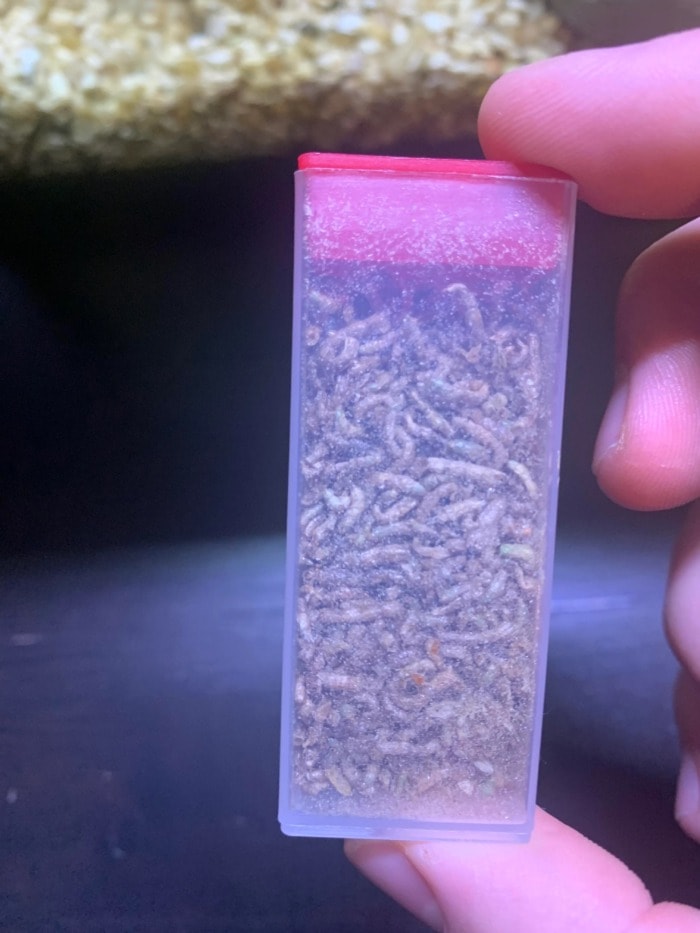
Freeze-dried foods are another common choice for feeding fish.
These are often the same bloodworms, larvae, and brine shrimp but they’ve been dehydrated.
Freeze-dried betta foods are a convenient and nutritious substitute for live or frozen foods. Freeze-drying is a preservation procedure in which the moisture or water content of food is completely removed without causing any impact on its nutritional value. Freeze-dried foods, such as bloodworms, offer essential nutrients to Betta fish and have several advantages.
Nutritional Value:
Freeze-dried foods retain much more nutritional value of the food. Freeze-dried foods are rich sources of protein, vitamins, and minerals; thus, they are necessary for the overall health and well-being of your Betta fish.
Convenience:
Freeze-dried foods are convenient and easy to store and use because refrigeration is unnecessary, and they have a longer shelf life. Freeze-dried bloodworms and other freeze-dried foods are available in small containers or packets, which allow for portion control and easier feeding.
Proper Preparation:
To ensure maximum digestion and avoid potential problems, it is recommended to rehydrate freeze-dried foods before feeding them to Bettas. Here’s the proper preparation process:
Rehydrating Freeze-Dried Food:
Keep the freeze-dried food in a small container. Pour aquarium water into the container and make sure the food is fully covered by water.
Allowing for Rehydration:
Allow the freeze-dried food to soak in the water for a few minutes to rehydrate fully. This makes rehydrating freeze-dried food soft and easier for Betta to eat.
While freeze-dried foods can be part of a balanced diet if used correctly, there are much better alternatives.
This is because some of their nutritional value is lost during processing, and they tend to expand after being eaten.
Freeze-dried foods don’t compare to or provide the same nutritional value as live or frozen foods.
They’re combined with fillers to keep them stable and also stripped of moisture.
While they may not be the greatest food option on the market, freeze-dried foods can be safely fed to bettas.
Soak freeze-dried food in tank water for a while before feeding it to your betta so it swells up before your fish eats it.
However, if I had to recommend one brand for a decent freeze-dried Betta snack I would go with Omega One. There are many brands for this, some better than others, but for some reason, all of my fish go insane for the Omega One treats.
You can find these foods in the following stores:
Another smaller but reliable store you can try for freeze-dried bloodworms would be Brine Shrimp Direct.
What Are Some Alternative Foods You Can Feed to Your Betta?
One of the best things you can do for your pet fish is to provide it with a varied diet to meet all its nutritional needs.
Sparingly using certain alternative foods, such as tropical fish flakes or pellets and suitable human foods, can effectively supplement the betta fish diet, improving your Betta fish’s overall health and wellness.
For some, this means adding tropical fish flakes or pellets to their betta’s diet; for others, it’s supplementing it with human foods.
Tropical fish flakes

Tropical fish flakes are one of the most popular fish supplements on the market.
These flakes are sprinkled on the top of an aquarium and float there to be picked off by hungry fish.
Tropical fish flakes can be beneficial to bettas, granted that you pick out the right kind.
As carnivores, bettas require food with at least a 30% crude protein content.
Select protein-based flakes, preferably those made explicitly for bettas.
Bettas have very short digestive tracts compared to other fish, and cannot process common food fillers like wheat or corn. The wrong kind of fish flakes can cause your fish to develop digestive issues, such as constipation and bloating.
Pellets
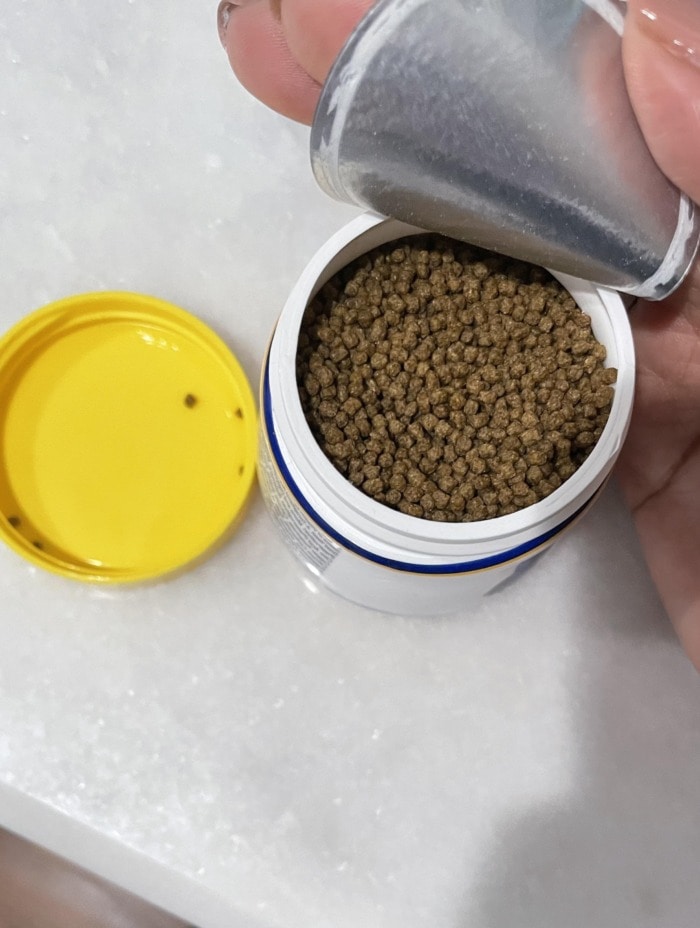
Another convenient food option for bettas is pellets.
These small balls float on the surface and sink as they absorb water.
Pellets are typically higher quality and easier to monitor than feeding flakes.
While pellets aren’t the most nutritious option, it’s okay to occasionally use them as treats for your betta.
Ideally, the pellets you offer should be smaller than your betta’s eyeball. You should limit their amount per feeding to match the fish’s eye size.
The best pellets for bettas are the ones that float and have the most natural ingredients and the lowest amount of plant matter in them.
Some of my favorites include the Omega Sea Betta Buffet Pellets and Aqueon Betta Pellets.
I recommend floating pellets because most bettas will not eat food off the bottom of their tank. While this won’t save you any money, it will decrease the chance of nitrate spikes caused by leftover food.
Advantages of Tropical fish flakes and pellets:
Tropical fish flakes and pellets are specifically formulated to offer a balanced diet for fish species, such as bettas. They are not only a primary source of nutrition; they also provide additional nutrients and essential minerals.
Supplemental Nutrition:
Tropical fish flakes and pellets consist of a combination of protein, fats, vitamins, and minerals that supplement the nutrients provided by live, frozen, or freeze-dried foods. When used sparingly, they can provide essential nutrients and minerals required for the growth, coloring pattern and well-being of Bettas.
Convenience:
Tropical betta fish flakes and pellets can easily be stored and handled; thus, they are an easy option for fish owners and aquarists. They can be a backup option when other food sources are unavailable.
Human food

Bettas can be fed with human foods only if they are tailored to their specific needs.
This, however, doesn’t mean they can survive solely on a diet designed for humans.
Their diets should be kept as close to their naturally developed habits as possible to avoid upsetting their delicate digestive systems.
The vast majority of our meat comes from land animals that bettas are not adapted to eat.
Furthermore, these meats contain a lot of additives that are harmful to fish.
Even though Bettas are carnivorous, they can tolerate limited portions of fruits and vegetables.
Fiber-rich peas and other vegetables are commonly used to treat digestive issues.
Any human food you offer your betta should be minimally processed as possible.
Here are some common human foods that Betta fish like to eat:
- Fresh seafood (raw)
- Chicken (unseasoned, cooked, and tiny slivers)
- Peas (boiled, skinned, and cut into quarters)
- Zucchini (cooked and skinned)
- Cucumber (boiled and skinned)
- Banana
- Mango
- Melon
In a pinch, homemade human food can be used for bettas when you’re out of fish food, but it shouldn’t be a long-term solution.
Author’s Note: Don’t feed your betta grains, acidic foods, or anything seasoned, salted, or processed. And remember, your fish’s stomach is only the size of its eye. Don’t overdo it!
What About Foods For a Baby Betta Fish?
Are you raising your own baby betta?
If so, congratulations!
The first thing you need to do is learn how to feed it.
Betta fry meals should consist mainly of live food like mosquito larvae, daphnia, brine shrimp, and microworms.
As they grow, they can be fed crushed pellets or frozen foods.
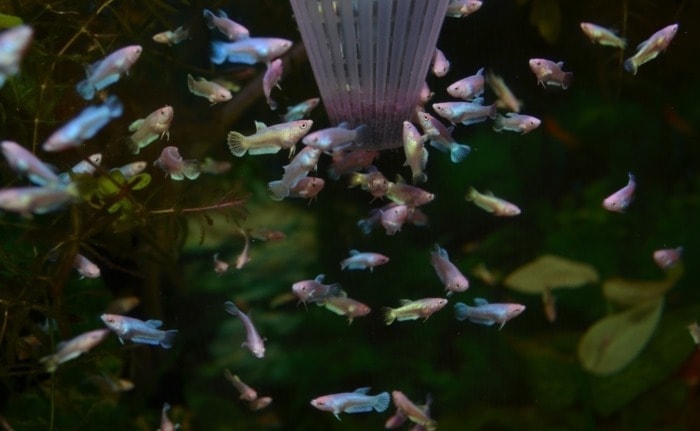
Most foods are too big for newly hatched bettas.
Start small with egg yolk, infusoria, and nematodes like microworms or banana worms, and work your way up to larger foods as they grow.
Just like many two-year-old’s, Baby bettas often turn out to be picky eaters.
I’ve heard horror stories from other betta owners about how their fish turned its nose up at just about everything they offered and would only eat one or two things consistently.
If you’re in the same boat as these poor fellows, then I advise you to switch food brands or even move on to live foods.
This will encourage your toddler fighting fish to find its true nature and unleash its inner hunter. On some occasions, however, this seemingly picky behavior could be a sign that something is wrong.
Dietary Needs of Baby Betta Fish:
Baby Betta fish are in a phase of rapid growth and development, so their energy needs are high, which is why they require a diet rich in protein, nutrients, and minerals. Plus, to avoid digestive problems and ensure maximum absorption, they should be fed good-quality, digestible foods.
The Best Baby Betta Food Options are:
Live Foods:
Live foods are a good source of protein and essential nutrients required for proper growth and development. Live foods for fry should be incorporated into your fish’s diet because they are nutritious and necessary for growth and overall health.
Micro Worms:
Microworms, like vinegar eels, are small organisms that baby Betta fish voraciously eat. They are a good source of protein, and Betta Fry can easily consume them because of their small size.
Infusoria:
Infusoria is a mixture of microorganisms, such as protozoa and algae, that may be found in old aquariums or can be made via the fermentation of organic vegetable matter. Infusoria is an easily digestible live food for fry and a good source of protein and other nutrients.
How Many Times Per Day Should You Feed Your New Pet Fish?

Even though Bettas don’t eat much, finding the exact amount they need might take some tweaking.
Adult specimens should be fed with small amounts of food once per day at the same time each day. Some fish keepers also opt for a 24-hour fast every other week to reduce constipation.
And that’s okay because most carnivorous fish can skip a meal for over a week without a problem.
On the other hand, baby bettas can eat as often as five times per day.
A proper betta feeding schedule is critical for the health and well-being of babies and adult betta fish. Here are the guidelines on feeding frequency for adult and baby fish:
Feeding Frequency for Adult Bettas:
Adult bettas should be fed once or twice a day. Feeding once in the morning and once at night is generally accepted and appropriate for adult Bettas. This provides them with the required nutrition, avoiding overfeeding.
Portion Control:
Provide a small portion of food that your fish can eat within 2–3 minutes. Betta Overfeeding a Betta can cause obesity, digestive problems, and degrade water quality.
Variety in Diet:
A variety of foods, for example, pellets, flakes, and live or frozen foods, should be provided to Betta fish, as it ensures a balanced diet.
Occasional Betta Fasting:
Your betta fish should be fasted one day per week to give their digestive system a break and avoid tympany. Fasting is beneficial for regulating appetite and reducing the chances of obesity.
Frequency for Baby Betta feeding:
Baby bettas, or fry, should be fed more frequently than adults due to their rapid growth and high metabolic rate. Feed Betta fry 3–4 times daily to aid their growth and development.
Small, Frequent Meals:
Provide small meals frequently to meet the energy requirements of betta fry.
Live Foods:
Live foods such as microworms, newly hatched brine shrimp, and infusoria are perfect food options for betta fry due to their high nutritional value and small size.
Portion Control:
Although Betta Fries are fed more frequently, it is crucial to avoid overfeeding. Provide a tiny amount of food that your betta can eat within a few minutes and get rid of any leftover food to maintain good water quality.
Importance of Portion Control and Avoiding Overfeeding:
Prevents Obesity:
Portion control can prevent obesity in Betta fish. Obesity can cause various health concerns, for example, bladder disorders.
Maintains Water Quality:
Leftover food in aquariums decomposes and pollutes aquarium water, causing ammonia spikes and other problems. Portion control will mitigate food waste and keep a clean and healthy environment for your betta fish.
Regulates Appetite: By setting a regular feeding schedule, you can regulate your betta’s appetite.
The quantity of food your betta should get per feeding will depend on the type of food.
To measure this, simply put a small pinch your food of choice in the aquarium and observe if it gets eaten in the next three minutes.
If it doesn’t, continue increasing the amount in the following feedings until your betta can no longer eat it under the allotted time.
Don’t forget to scoop up the leftovers with a food scraper.
Common Mistakes to Avoid When Feeding Betta Fish:

Feeding your betta fish may appear easy and plain, but owners are liable to make common mistakes that have a harmful impact on the fish. Here are some pitfalls to avoid.
Betta Fish Overfeeding:
Overfeeding is one of the most common mistakes pet owners often make. Overfeeding can cause various health issues, such as betta fish constipation, obesity, and digestive problems. Bettas have a small stomach that becomes full and bloated if fed too much.
Poor Quality Betta Food:
Feeding poor-quality foods is another mistake that contributes to deficiencies, weak immune systems, and health compromises. Many commercial fish foods may not cater to the nutritional needs of fish because they lack essential nutrients or container fillers.
Ignoring Dietary Variety:
Even though Bettas are carnivores and need a protein-rich diet, their food should be composed of a variety of feed ingredients; solely relying on one type of food contributes to nutritional deficiencies. It is important to offer dietary variety by including live, frozen, and freeze-dried foods in the diet of Betta fish. This is essential for the proper growth and health of your fish.
Health consequences of these mistakes:
Constipation or Bloating: Overfeeding or feeding low-quality food can cause betta fish constipation and bloating. Neglecting these signs can cause more severe health concerns, such as bladder and organ damage.
Signs Your Betta Fish Isn’t Getting the Right Nutrition:
Making sure that your betta fish gets the appropriate nutrition is necessary for their health and growth. Many physical and behavioral signs show that your Betta isn’t getting the right nutrition.
Betta Fish Lethargy:
Lethargy can be a sign of malnutrition or a deficiency of essential nutrients in the diet. A lethargic fish exhibits signs of a lack of energy and spends more time resting at the bottom of the tank or floating near the surface.
Betta Fish Color Loss or Fading:
Bettas are colorful and vibrant fish species; loss of color or fading can signify malnutrition. Poor-quality diets can cause dulling of color or non-uniform pigmentation on the fins or body of fish.
Fin Damage:
Fins can be frayed or torn due to nutritional deficiencies or poor water quality. If any signs of fin damage are observed, it indicates malnutrition or deficiency. A balanced diet with all essential nutrients is necessary for regrowth.
Distended Belly:
A distended belly or abdomen can be a sign of betta fish malnutrition, overfeeding, or constipation. Feeding inappropriate or lower-quality diets can cause digestive issues and bloating in fish.
Betta Fish Health Problems:
In severe cases of malnutrition, Bettas might suffer numerous health issues, for example, compromised immune systems, susceptibility to diseases, and a reduced life span. If there are constant signs of malnutrition or poor nutrition, it is advisable to evaluate their diet and adjust it so that your fish receive proper nutrition.
Creating a Feeding Schedule for Your Betta:

Setting a proper feeding schedule is crucial for the health and wellness of your betta fish. Here are some guidelines for making an effective feeding regimen:
1. Betta Fish feeding Routine:
Feed your betta fish at the same time each day to create a routine.
Choose the times when you are likely to observe the feeding behavior of your betta fish, for example, in the morning or evening.
2. Portion Control:
Provide a smal amount of food that your Betta fish can eat within 2–3 minutes.
Betta fish have small stomachs, so don’t exceed their stomach capacity. Keep in mind that it’s better to feed less than overfeed.
3. Observing Betta Eating:
Notice and regularly observe your betta fish’s eating habits to ensure they are receiving enough food. A healthy fish swims and eats the food happily.
How to Store Betta Fish Food:
Proper storing of betta fish food is critical for maintaining its freshness and nutritional value. Here’s how to store different types of betta food effectively:
1. Live Food:
Live food such as brine shrimp, bloodworms, or daphnia should be stored in cultures specific to each organism’s needs.
When culturing live food, follow the advice to provide favorable conditions for growth and reproduction.
Remove dead and decomposing organisms from the water promptly and monitor the live food culture regularly.
2. Frozen Food:
Frozen foods should be kept in the freezer at a temperature below zero degrees Fahrenheit to maintain food quality.
Frozen foods should be kept in airtight containers or resealable bags.
Before using packaged frozen foods, check the expiration date.
3. Dry Food (Pellets or Flakes):
Dry betta food should be stored in a dry and cool place where there is no chance of reaching sunlight or moisture.
Utilize airtight containers to prevent dry food from contacting the air or humidity.
Keep dry foods away from heat sources like radiators or stoves.
Before using, check the food expiration date.
My Closing Thoughts
Bettas are one of the most popular beginner fish for a reason.
Offering a variety of foods rich in nutrients is extremely necessary for the health and growth of Betta fish. A balanced diet containing live, frozen, freeze-dried, and dry food is necessary for the health and well-being of Betta fish, which guarantees optimal growth.
A balanced and healthy diet is not only necessary for the physical health of betta fish but also for their vibrant color, sturdy fins, and vitality. A proper diet with a variety of nutrients can boost the immune system, improve their behavior, and even increase the lifespan of your betta fish, which guarantees a healthy betta fish.
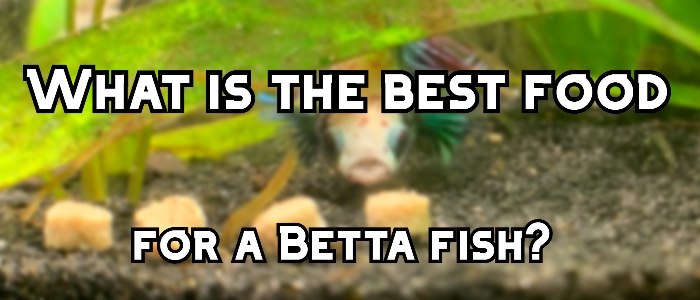
Their resilience lets them tolerate a lot of the mistakes inexperienced fish keepers tend to make.
Nevertheless, the tolerance of these feisty little creatures isn’t limitless. If you want to enjoy their company in the long run, you should learn how to feed them properly.
Hopefully, this article marks the beginning of a long and fruitful companionship!



